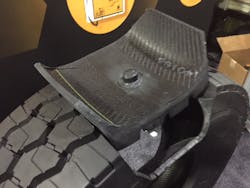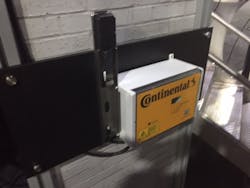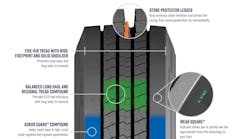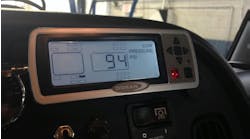Tires are a major pain point for motor carriers, representing one of their top three operating costs, right after driver wages/benefits and fuel.
They can also represent a major safety issues as well: out of the 40,944 Level I inspections conducted on commercial vehicles during the annual 72-hour Roadcheck International roadside inspection blitz this year, 9,398 of them were placed out of service, with 15.1% of those violations directly related to tire and wheel problems.
Maintaining proper tire pressure is not only critical to avoiding tire-related safety problems but also key to ensuring fleets obtain the maximum mileage and fuel economy benefits from them as well.
To address those issues and more, Continental is introducing a digital tire monitoring platform dubbed “ContiConnect” that will allow fleets to remotely track and manage truck and trailer tire air pressure via sensors installed within the tires themselves.
During a press conference at the recent North American Commercial Vehicle (NACV) show, Continental explained that tire data is collected via a round battery-powered sensor glued on the inner liner of the tire.
As trucks enter a fleet’s yard, a “reader station” then picks up data from the sensors and transmits it to the ContiConnect web portal via a cellular network. Via that portal, fleet managers and other maintenance personnel can track low pressure alerts, high tire temperatures, as well as track data over time, Continental said.
The supplier said those sensors can be factory-installed on new tires or retrofitted to existing ones. They are mounted within the liner to more accurately detect the tire temperature and pressure without being influenced by heat from braking systems, Continental added.
The platform also features customizable text and email notifications so fleet personnel can receive immediate alerts when low tire pressures or high tire temperatures are detected, the supplier added; allowing fleets to act proactively to fix issues rather than spending valuable time performing manual pressure checks.
Continental’s engineers said the battery powering the tire sensor can last up to six years, allowing the sensor to be “re-used” as tires are replaced or transferred within a fleet. It can also help deter theft as tire location can be tracked via the sensors, they noted.
The company added that the “reader station,” which collects and transmits the tire sensor data, needs to be within 65 ft. of a truck or trailer to accurately collect that information. Usually, the best spot is near a refueling island, Continental’s experts said.
The supplier also envisions using the reader/cellular network part of the ContiConnect system as a “base” upon which to expand fleet data collection and analytical services.
The tire pressure monitoring system offers data integration with multiple telematics providers, including Zonar, which is majority-owned by Continental, and independent third party PeopleNet, the company noted.
Such “integration” allows tire data to be seen in both the providers’ in-cab displays and back-end portals, Continental pointed out.





